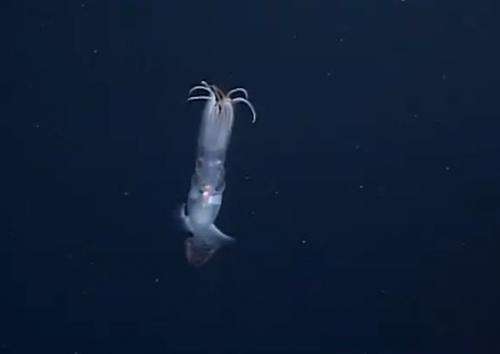August 28, 2013 report
ROV video offers clues on how rare squid catches prey

Bob Yirka
news contributor

(Â鶹ÒùÔº) —Video captured by a camera aboard a Remotely Operated Vehicle (ROV) off the coast of southern California is offering scientists clues to help explain how the rare squid Grimalditeuthis bonplandi, manages to catch prey without benefit of suckers or hooks. The research team behind the project (with the Monterey Bay Aquarium Research Institute) has published a paper in Proceedings of the Royal Society B describing their findings and offering a perspective on how the squid might use its unique appendage to capture prey.
Most squid catch prey by extending tentacles with suckers or hooks on them and grabbing what they're after—G bonplandi can't do that because it's single tentacle is too thin and doesn't have either suckers or hooks—or any other tools for grabbing anything. For that reason, researchers have been mystified for years regarding how it catches prey. Observing the squid has been difficult—they live at depths greater than 1000 meters where it's pitch black dark. Until 2005, no one had ever captured one on video before, much less seen it in person in its native habitat—prior to that marine biologists only knew about its existence because specimens had been found in the bellies of fish.
Since 2005, other video cameras aboard ROVs or affixed to oil platforms have also captured video of the mysterious squid. Unfortunately none of the video shows the squid actually capturing and eating something. But the video does offer tantalizing clues.
After analyzing all the video, the researchers on this new effort suggest that the squid uses its tentacle as a lure, casting it about in hopes of attracting the attention of prey. The lure, or club as it's called, would be the envy of human fishermen as it has thin membranes on its sides that can be manipulated to allow for controlling where it goes. The researchers believe the squid captures the attention of other organisms in the nearby water with its movements, causing some of them to turn on their bioluminescence, which allows the squid to see and perhaps grab prey with its "arms." It's also possible, they suggest, that the movement of the club causes vibrations that attract small prey.
Written for you by our author —this article is the result of careful human work. We rely on readers like you to keep independent science journalism alive. If this reporting matters to you, please consider a (especially monthly). You'll get an ad-free account as a thank-you.
More information: First in situ observations of the deep-sea squid Grimalditeuthis bonplandi reveal unique use of tentacles, Published 28 August 2013
Abstract
The deep-sea squid Grimalditeuthis bonplandi has tentacles unique among known squids. The elastic stalk is extremely thin and fragile, whereas the clubs bear no suckers, hooks or photophores. It is unknown whether and how these tentacles are used in prey capture and handling. We present, to our knowledge, the first in situ observations of this species obtained by remotely operated vehicles (ROVs) in the Atlantic and North Pacific. Unexpectedly, G. bonplandi is unable to rapidly extend and retract the tentacle stalk as do other squids, but instead manoeuvres the tentacles by undulation and flapping of the clubs' trabecular protective membranes. These tentacle club movements superficially resemble the movements of small marine organisms and suggest the possibility that G. bonplandi uses aggressive mimicry by the tentacle clubs to lure prey, which we find to consist of crustaceans and cephalopods. In the darkness of the meso- and bathypelagic zones the flapping and undulatory movements of the tentacle may: (i) stimulate bioluminescence in the surrounding water, (ii) create low-frequency vibrations and/or (iii) produce a hydrodynamic wake. Potential prey of G. bonplandi may be attracted to one or more of these as signals. This singular use of the tentacle adds to the diverse foraging and feeding strategies known in deep-sea cephalopods.
Journal information: Proceedings of the Royal Society B
© 2013 Â鶹ÒùÔº




















